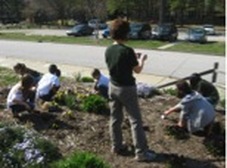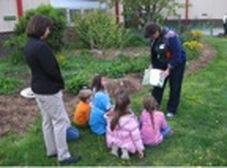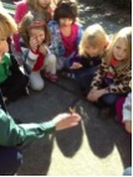Volunteer Projects
Virginia Master Naturalists are engaged in a variety of local, state, regional, and national projects through their volunteer service. Read below to see just a few examples!
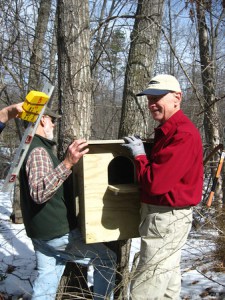
The Wild Life of the Headwaters Chapter
When the internationally renowned hospital for injured and orphaned wildlife and VMN partner organization The Wildlife Center of Virginia needed an entrance garden that reflected its dedication to wildlife and ecology, the Virginia Master Naturalist Headwaters Chapter picked up its shovels and knowledge of regional ecology and stepped in. The Headwaters Chapter serves Augusta and Rockingham counties in Virginia’s Ridge and Valley, partnering with the Wildlife Center, created a demonstration Wildlife Habitat garden at the Center to replace invasive plants with native, wildlife supporting ones. They built a pond, installed nest boxes, and educational signage. So thorough in their research, the group planted a grove of seedlings to be harvested for fawn and bear browse and a small raised bed plot will grow native foods to supplement the diets of the wild patients in the hospital. "We labored and laughed until lunch break , building the raised beds and installing the foundations for the rain barrels,” writes project coordinator, Kate Guenther, describing the Headwaters Chapter February focus project. "A record 18 people showed up to help! By lunch it was warmer, and we stood around our work eating hot soups and stews."
When the internationally renowned hospital for injured and orphaned wildlife and VMN partner organization The Wildlife Center of Virginia needed an entrance garden that reflected its dedication to wildlife and ecology, the Virginia Master Naturalist Headwaters Chapter picked up its shovels and knowledge of regional ecology and stepped in. The Headwaters Chapter serves Augusta and Rockingham counties in Virginia’s Ridge and Valley, partnering with the Wildlife Center, created a demonstration Wildlife Habitat garden at the Center to replace invasive plants with native, wildlife supporting ones. They built a pond, installed nest boxes, and educational signage. So thorough in their research, the group planted a grove of seedlings to be harvested for fawn and bear browse and a small raised bed plot will grow native foods to supplement the diets of the wild patients in the hospital. "We labored and laughed until lunch break , building the raised beds and installing the foundations for the rain barrels,” writes project coordinator, Kate Guenther, describing the Headwaters Chapter February focus project. "A record 18 people showed up to help! By lunch it was warmer, and we stood around our work eating hot soups and stews."
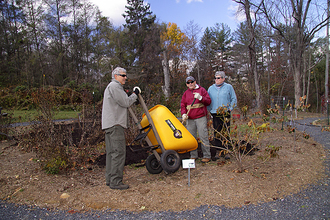
Old Rag Chapter's Town of Washington Project
The Town of Washington Project started in the winter of 2011 as a joint project between the Old Rag Chapter of the Virginia Master Naturalists and the Town of Washington, Virginia. This project is a land restoration project on land owned by the town in an area that lies between the town’s new state-of-the-art Waste Water Treatment Facility and a main thoroughfare of the little town. In the first two years of this project, with help from grants to the town, ORMN volunteers have been able to complete 2/3 of the designed walking trails and four of the six planned gardens. The trail and two remaining gardens will be completed by June 2014. One of our partners, RLEP, provided funding for a bridge to be constructed along the walking path, and construction of that bridge was donated by Joe Kaiser, a resident of Rappahannock County. An additional grant to Washington was provided by the Culpeper Soil and Water Conservation District, another of our partners, to create a demonstration rain garden, which was completed in 2013. Students from Rappahannock County High School assisted with that project. The Virginia Native Plant Society conducted a plant survey on the property in 2013 to determine if there were any rare plants that needed to be protected. The goal of having more community involvement is being realized, and after the plantings begin blooming in the spring of 2014, even more interest may be generated within the community. Fourteen (14) Old Rag Master Naturalists have contributed 315 hours to this project.
The Town of Washington Project started in the winter of 2011 as a joint project between the Old Rag Chapter of the Virginia Master Naturalists and the Town of Washington, Virginia. This project is a land restoration project on land owned by the town in an area that lies between the town’s new state-of-the-art Waste Water Treatment Facility and a main thoroughfare of the little town. In the first two years of this project, with help from grants to the town, ORMN volunteers have been able to complete 2/3 of the designed walking trails and four of the six planned gardens. The trail and two remaining gardens will be completed by June 2014. One of our partners, RLEP, provided funding for a bridge to be constructed along the walking path, and construction of that bridge was donated by Joe Kaiser, a resident of Rappahannock County. An additional grant to Washington was provided by the Culpeper Soil and Water Conservation District, another of our partners, to create a demonstration rain garden, which was completed in 2013. Students from Rappahannock County High School assisted with that project. The Virginia Native Plant Society conducted a plant survey on the property in 2013 to determine if there were any rare plants that needed to be protected. The goal of having more community involvement is being realized, and after the plantings begin blooming in the spring of 2014, even more interest may be generated within the community. Fourteen (14) Old Rag Master Naturalists have contributed 315 hours to this project.
|
Grafton Bethel Elementary Nature Restoration Project
Working with multiple partners (Virginia Master Gardeners, Virginia Native Plant Society, Stonehouse Elementary School, the local PTA, Boy Scouts of Troop 200, Yorktown Wild Birds Unlimited, Brent and Becky's Bulbs in Gloucester, Kiwanis, Ken Matthews Garden Center), the Historic Rivers chapter has planted a native plant garden on the grounds of the Grafton Bethel Elementary School. The site is being used to teach students about the importance of native plants and their pollinators and, as a Monarch Way station, students are able to learn about Monarchs and participate in citizen science initiatives by raising and tagging the species. Through the efforts of our volunteers, students, and partners, the garden has been certified by the Virginia Department of Game and Inland Fisheries as a Virginia Habitat Partner and continues to serve as an important site for environmental education in the community. "One story that was a highlight to the end of the project was this: One second grade class had been very enthusiastic about the project, but unfortunately one butterfly failed to emerge and the other emerged with crumpled wings. The teacher and students were very disappointed, and they were unable to come to the last tagging event of the season. I went outside to release another butterfly and saw an untagged male monarch flying up in the branches of one of the trees in the getaway. I watched for a while as it happily flew out of reach. All I had was a small plastic aquarium, but I asked the butterfly, “Please come down here, I really need another butterfly.” After a little more pleading the butterfly calmly floated down and landed on a bush in front of me. I crept up behind it and placed the aquarium over it. To my amazement I caught that butterfly! It was by far the wildest of all the ones we had tagged all season, beating its wings against the container, no longer the calm butterfly that had floated down from the tree. I rushed inside to the classroom and the students were thrilled to have a chance to tag a butterfly after all. It was no easy task to tag the butterfly that would not sit still for a moment. We tagged him, took him out to the getaway and the kids did a countdown to release. He took off like a shot, students cheering, everyone smiling, and the butterfly happy to be free again. It was by far my most memorable tagging of the season." -Stephanie Schmuck, Historic Rivers Chapter Volunteer |

Returning Bluebirds to Bluebird Gap Farm
Bluebird Gap Farm is a 60-acre park in urban Hampton, Virginia. Previously a farm, the history of the property dates back to the 1600s. Bluebird Gap Farm is surrounded by an Interstate highway, the Power Plant shopping center, Hampton Coliseum, and housing developments. The Peninsula chapter recently began revitalizing the Bluebird Trail found there. With a grant from the Virginia Bluebird Society to cover nesting box costs and donations from Yorktown Wild Birds Unlimited (discount on the cost of the pole setups and 3 new front-opening “House sparrow-resistant” boxes), the chapter was able to restore bluebirds to the Farm. Data from boxes monitored from April-July found the following:
Bluebird Gap Farm is a 60-acre park in urban Hampton, Virginia. Previously a farm, the history of the property dates back to the 1600s. Bluebird Gap Farm is surrounded by an Interstate highway, the Power Plant shopping center, Hampton Coliseum, and housing developments. The Peninsula chapter recently began revitalizing the Bluebird Trail found there. With a grant from the Virginia Bluebird Society to cover nesting box costs and donations from Yorktown Wild Birds Unlimited (discount on the cost of the pole setups and 3 new front-opening “House sparrow-resistant” boxes), the chapter was able to restore bluebirds to the Farm. Data from boxes monitored from April-July found the following:
- Tufted titmouse: 2 nests, 11 nestlings, reproductive success = 78.6%
- Carolina chickadee: 1 nest, 6 nestlings, reproductive success = 100%
- Eastern bluebird: 2 nests, 7 nestlings, reproductive success = 70%
- 29.4% of the 15 boxes were used
- 33.3% of the “sparrow-proof” boxes were used
- There were no problems with house sparrows

